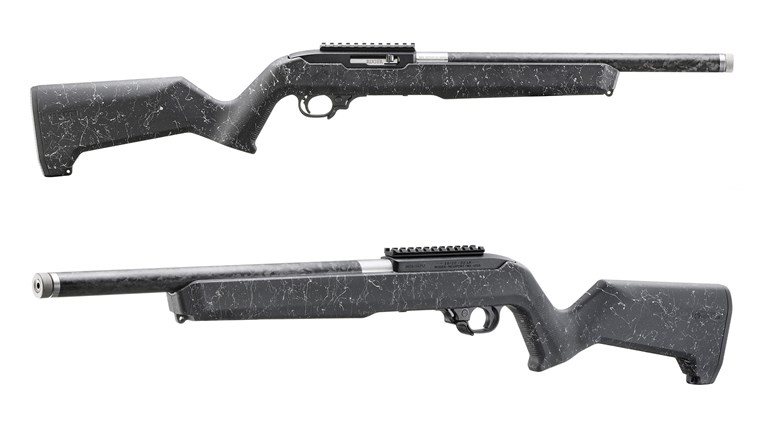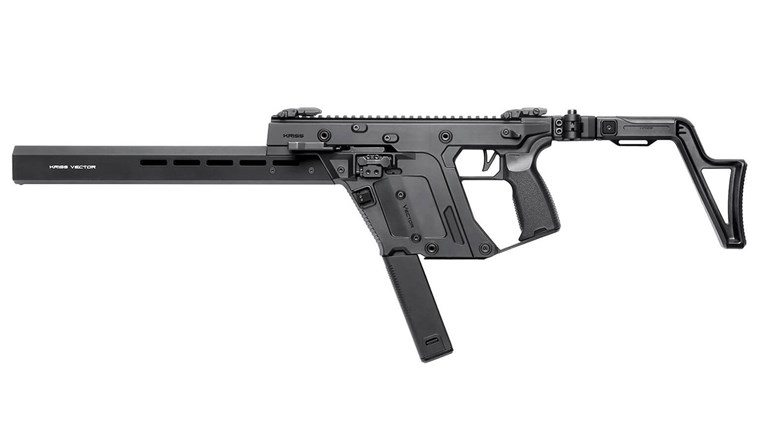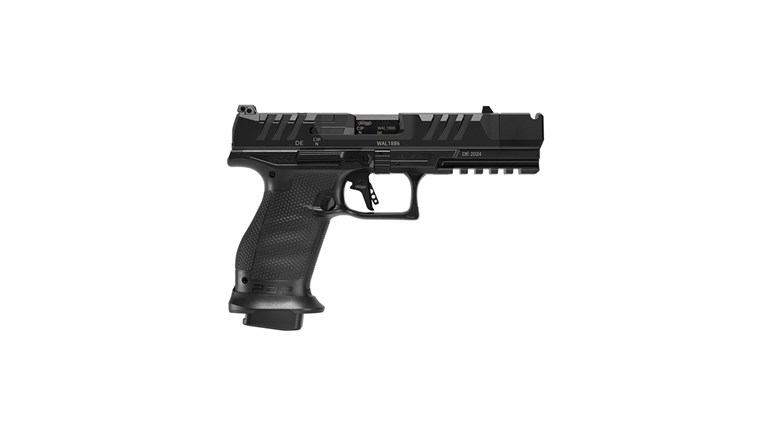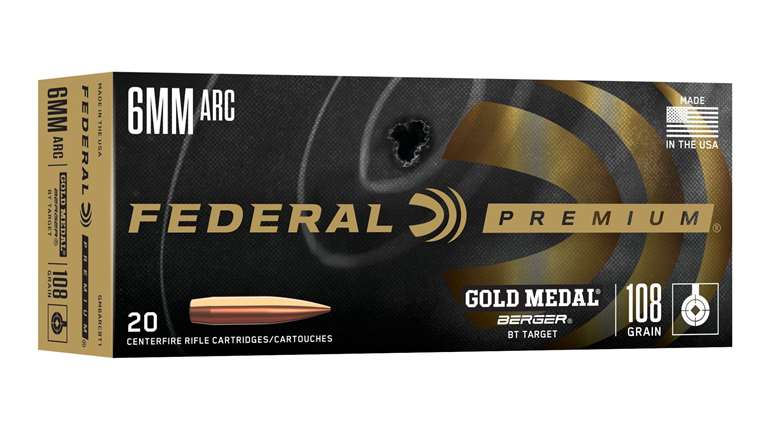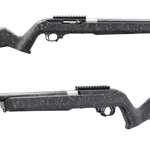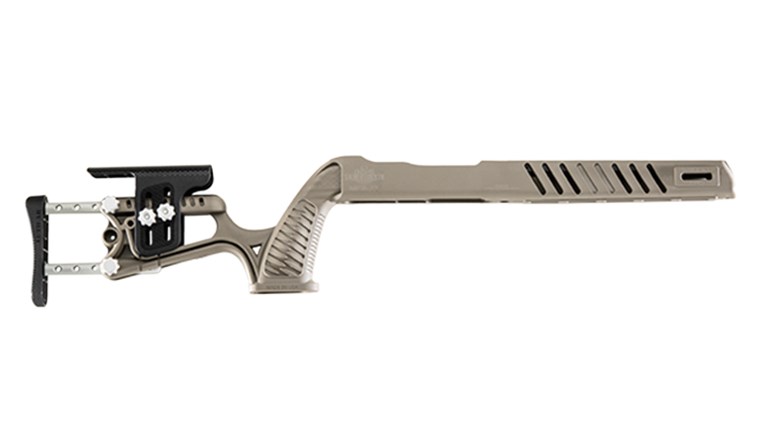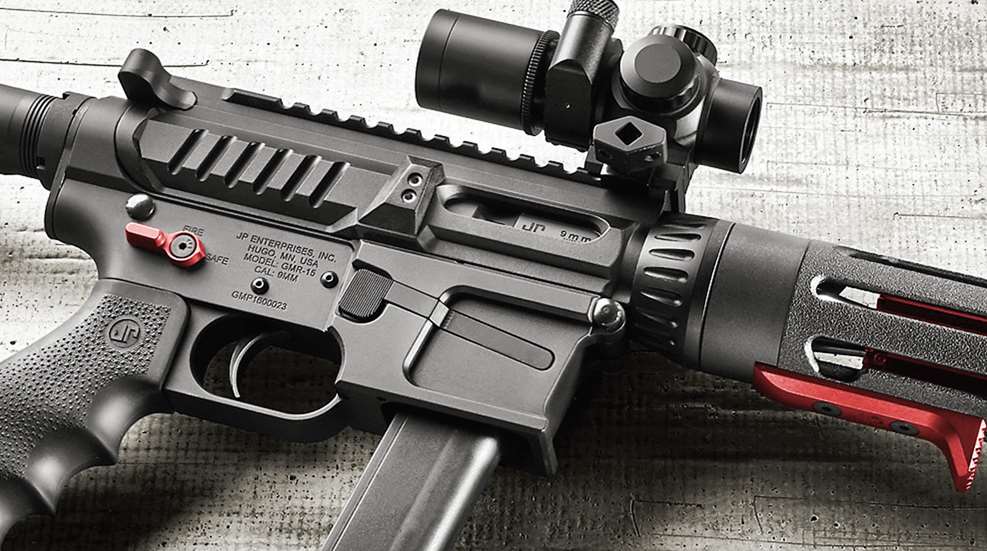
Everyone knows that JP Enterprises is known far and wide for top of the line rifles; their reputation has been earned and maintained for a number of years. Having spent very little time shooting rifles or carbines, I had little knowledge of JP’s product line. However, once the GMR-15 arrived and the box and the soft case that comes with the GMR-15 (starts at $1699) were opened, there was no doubt―this carbine is an eye-catcher at first glance, and the beauty is more than skin deep.
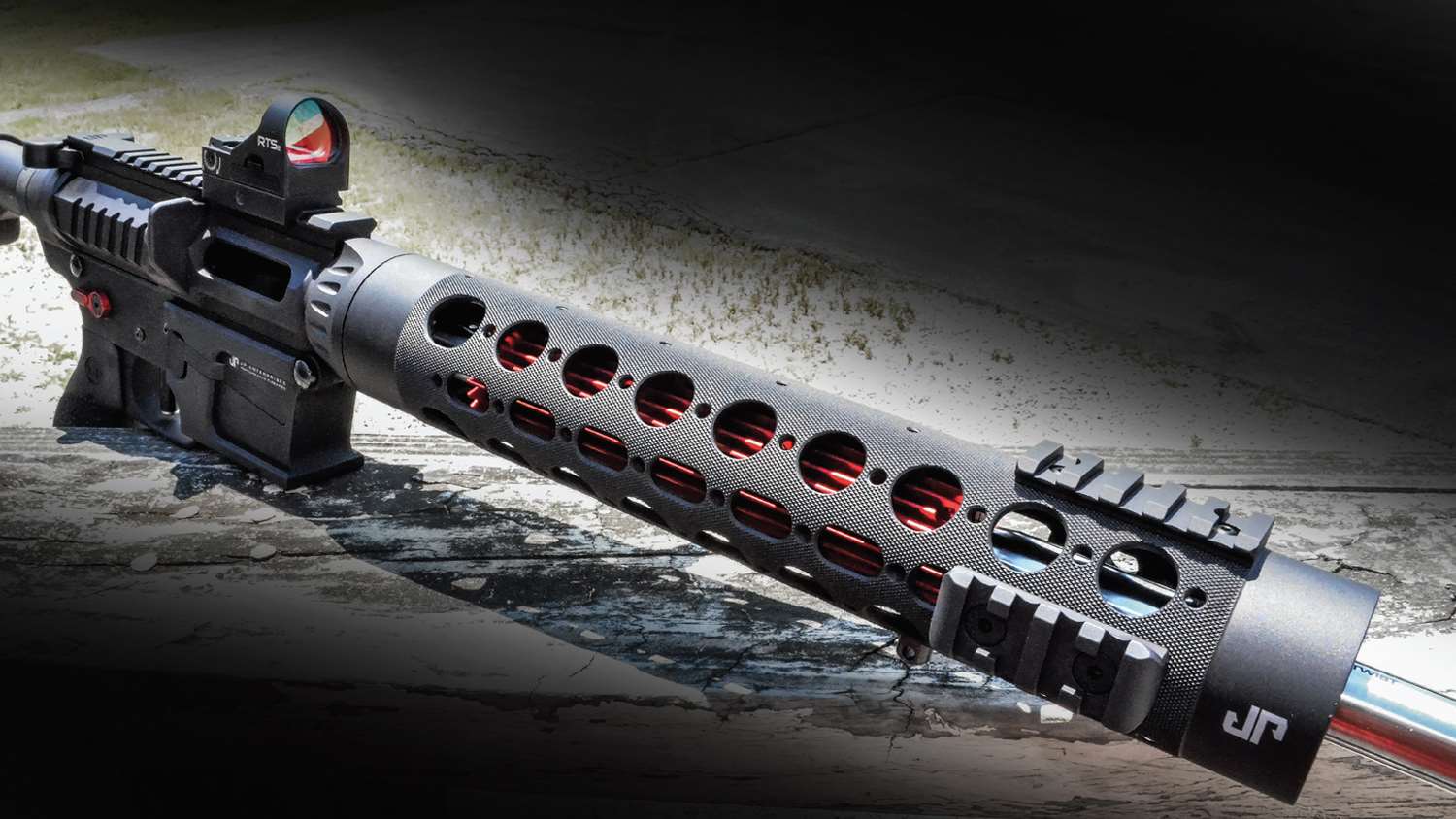
The GMR-15 is a fine-looking gun; the red thermal dissipater and red barricade brace, and the barrel and compensator with the stainless finish offset the black of the carbine, and draw even the casual person in for a closer look. The carbine has a section of rail on the receiver for mounting optics, sights and whatever other tools that are needed or desired. The aluminum hand guard is round and fitted with several pieces of rail as well. There is a barricade brace and a couple of different sling attachments that came on the carbine. It came with a JP compensator that was so smoothly polished it looked like it was a part of the barrel. The safety selector is also red and ambidextrous. (Ambidextrous features should be far more common in the gun industry in order to increase the practicality of the firearms, and the other-handed people find it useful as well.) The stock is adjustable, with three positions between all the way forward and all the way to the rear, allowing it to fit a variety of shooters and positions. The carbine has the traditional charging handle of the AR platform, and has a charging handle on the left side of the receiver that is absolutely handy. The magazine release is located on the right side of the receiver and it is large and square; the trigger finger finds it easily, and it is comfortable to use. The carbine came with a single 10-round Glock magazine.
The trigger was an event unto itself. This is a round trigger that rolls on the finger as it is pressed and is estimated to break at somewhere less than three pounds. The trigger was impressive and broke crisply. Prior to firing the carbine there were doubts about the trigger and its unique composition. How useful would a round trigger be? How much of an adjustment would it require to get accustomed to the trigger? The short answer is that the trigger worked well and there was no adjustment necessary.
Since neither Jake Martens (USPSA director of media), nor I are riflemen, carbines and rifles are outside of our wheelhouse―but, in the spirit of Quigley Down Under, we can use them, it is just not a passion. In order to supplement our knowledge and experiences with the carbine, other opinions were solicited and included in the testing of this carbine.
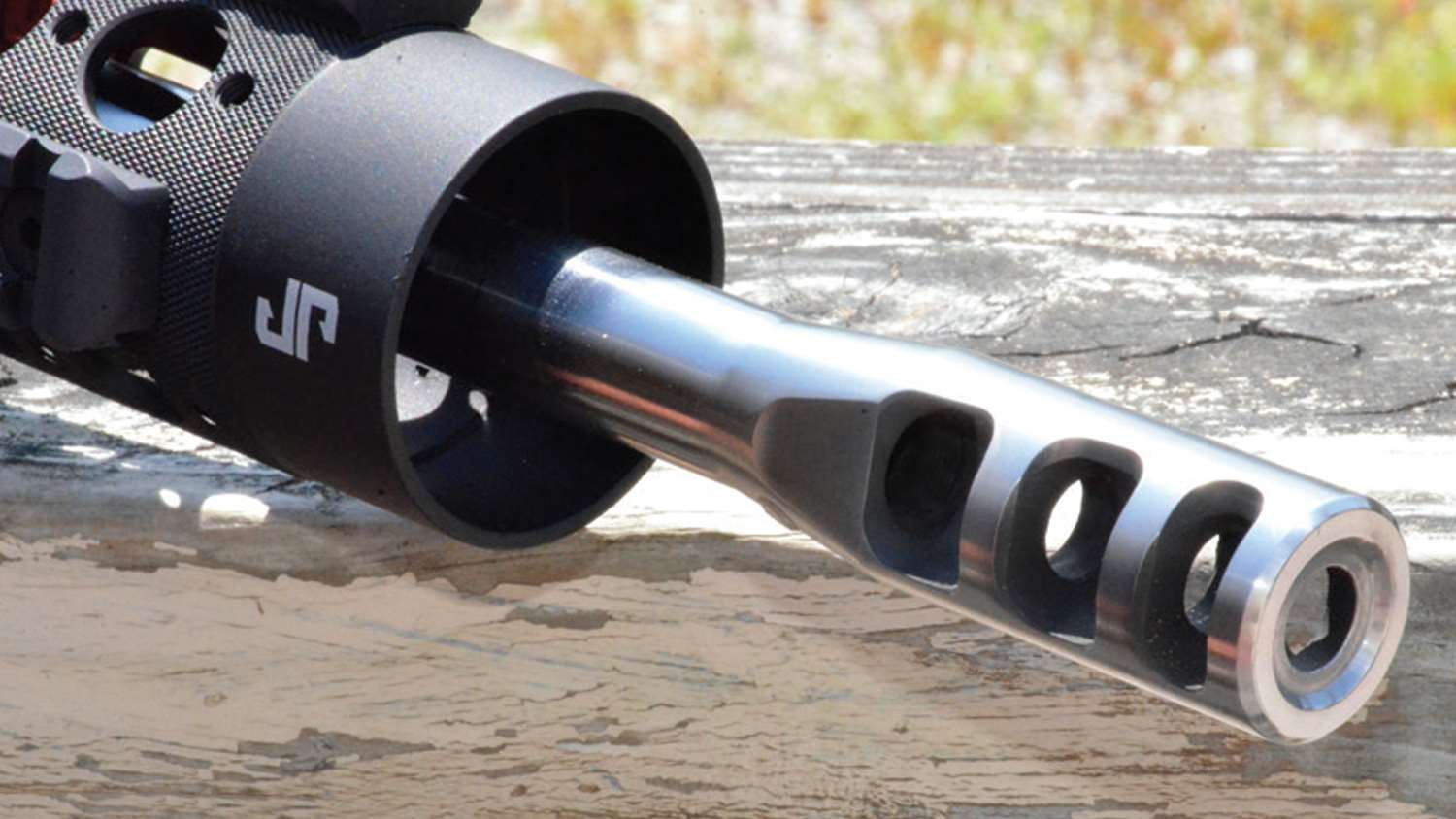
Following the Mile High Showdown in June, I spent a couple of days at the NRA Whittington Center. During that stay, I shared a sitting room and kitchen with a couple of gentlemen; on the second night I brought the GMR-15 out and asked them to look it over and give me their impressions. I told them I was writing a review and I wanted their unvarnished opinions. I had not met either gentleman prior to this trip; one was a retired Special Forces sergeant, and the other a gunsmith who builds rifles, neither of whom competed in USPSA. In handling the GMR-15, both were immediately impressed. The gunsmith stressed that the fit and the finish of this gun were top-notch and very impressive, and I understood that he did not hand out positive comments without cause. The sergeant noted that the fit was excellent and that there was no wiggle from where the lower joins the upper. Both were emphatic that the gun was well-constructed, and were blown away on how well the muzzle brake was fitted to the barrel. While dry-firing the gun, both sang the praises of the trigger, that it was smooth as glass. The only concern was the question of why bother putting a compensator on a 9mm carbine. One said that the compensator was superfluous, and his point is understood. “How much recoil can be found in a 9mm carbine?” he asked. This is a legitimate question in many respects, and did not reflect on the quality of the gun. After spending two evenings talking and listening to these two men it’s safe to say they can find fault easily enough. If there were weaknesses they would have been pointed out.
So what is the point of this compensator on a 9mm carbine? Is the compensator really superfluous? It seems logical that for reasons involving the marketplace, and the competition that may develop in the Pistol Caliber Carbine (PCC) arena in the next few years, that a compensator is not excess but necessary. Is the compensator necessary for handling the recoil that the competitive shooter will face? Absolutely not, if the shooter owns a “man card”, or even has a notion to one day have a man card. The lack of a man card does not require a compensator either; I cannot think of a single female competitor who would need a compensator on their PCC. Sometimes the features of a competition gun are not there because we need them, but because we want them; plus, this compensator brings the “WOW” factor, and it is just really cool.
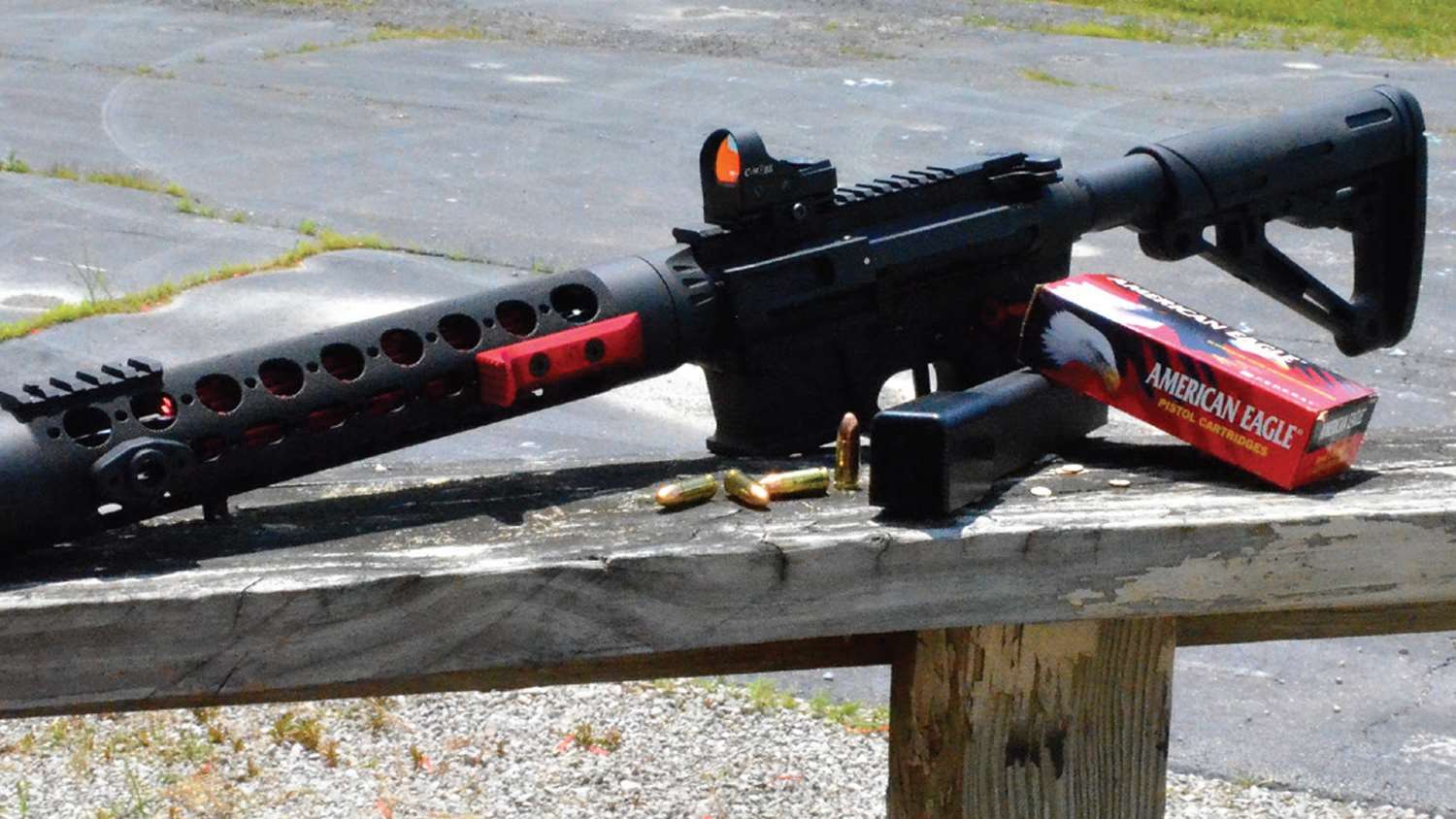
Back in Indiana, several local competitors shot the carbine because they wanted to see what the recoil was like and if it was less than their own PCC. Without a doubt, recoil is on the mind of the PCC shooter who wants to have the fastest splits possible―so for the PCC marketplace, the compensator seems to be necessary because the competition folks want to achieve a reduction in the recoil impulse if at all possible, regardless of how slight the recoil may be. Superfluous, to a gamer? Not hardly.
When the GMR-15 came, the C-More RTS2 dot went on it that day and the sight-in process was completed. There are 25 yards available at Parabellum on the indoor range. Sighting in was pretty simple, and no further adjustments were made on the optic for the rest of the shooting that was done. This optic served the purpose of the testing. The RTS2 would not be most people’s first choice for PCC but it was available, and it worked.
The first range session was prior to the SNS Casting Indiana 400, and saw 300 rounds go through the GMR-15. This session served to scope out the features of the GMR and get somewhat accustomed to the whole PCC thing. The majority of ammo used was American Eagle 124-grain supplied by Federal Premium. The GMR ran without a single malfunction of any kind. I also used 100 rounds of my own reloads, and once again, no issues of any type were encountered. (If it will run on my reloads it should run on anything, as I struggle at the loading bench with 9mm.)
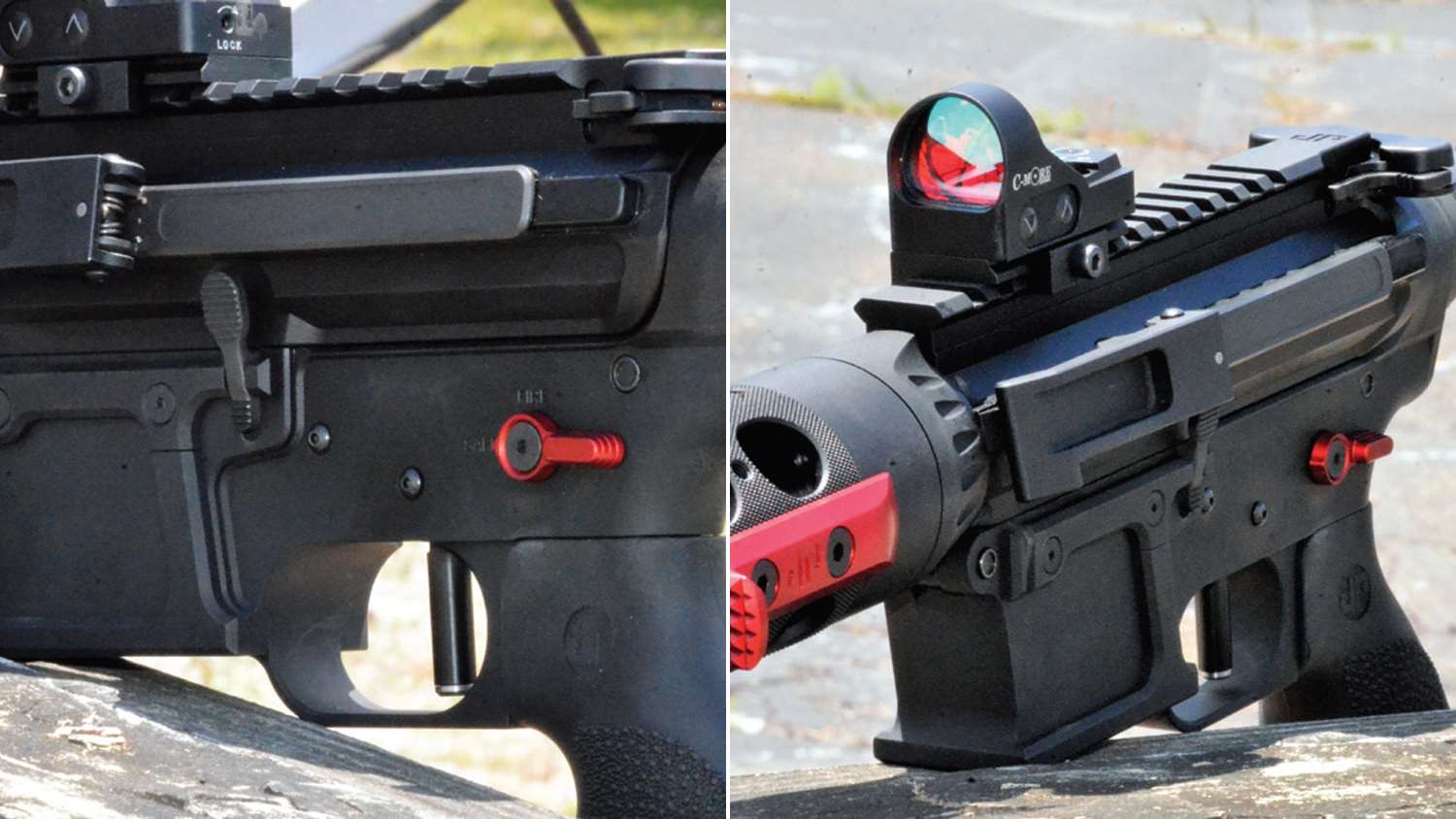
A number of three- and four-target arrays were used during this session. The timer was involved but no times were recorded, as this session was meant to get acquainted with the carbine, and to test its reliability. It was assumed that my times with the carbine would not rival the times of the shooters at the top end of the food chain in PCC, and that proved to be correct. In all arrays the target was never closer than 15 yards, and many shots were taken at the 35- to 40-yard distance. When the session was over, the distant target was shredded in the A-zone with less than a handful of Charlies and not a single Delta. After reading the owner’s manual warning about how inaccurate the carbine can be, there was concern about how well the gun would perform; this first session put my concerns to rest. The gun is more than accurate enough to shoot really good points on all courses of fire in USPSA and Steel Challenge. Some arrays ranged from 15 to 35 yards with a total of four targets. Some three-target arrays were shot at 20 yards. In both of these scenarios two or three shots per target were the norm, and making transitions at this distance with good hits was fairly easy. Most of the targets had clumps of pasters in the A zone and just a few C zone hits on each target.
This first trial session demonstrated that the gun ran and functioned well, and that it was more than accurate enough.
The first range session also brought a few features of the gun into the spotlight, the rolling, straight trigger being one. Would the unique trigger take a bit of adjustment? In previous reviews on the Q5 and the X5, settling into the gun made a difference in performance. The trigger on the GMR-15 is completely different from any other trigger; however, there was no need to settle in to get performance with this one. It was easy to use and very user-friendly. The smooth, clean-breaking trigger was a joy, and required no conscious thought to use. JP Enterprises does triggers well―the rolling trigger is no gimmick.
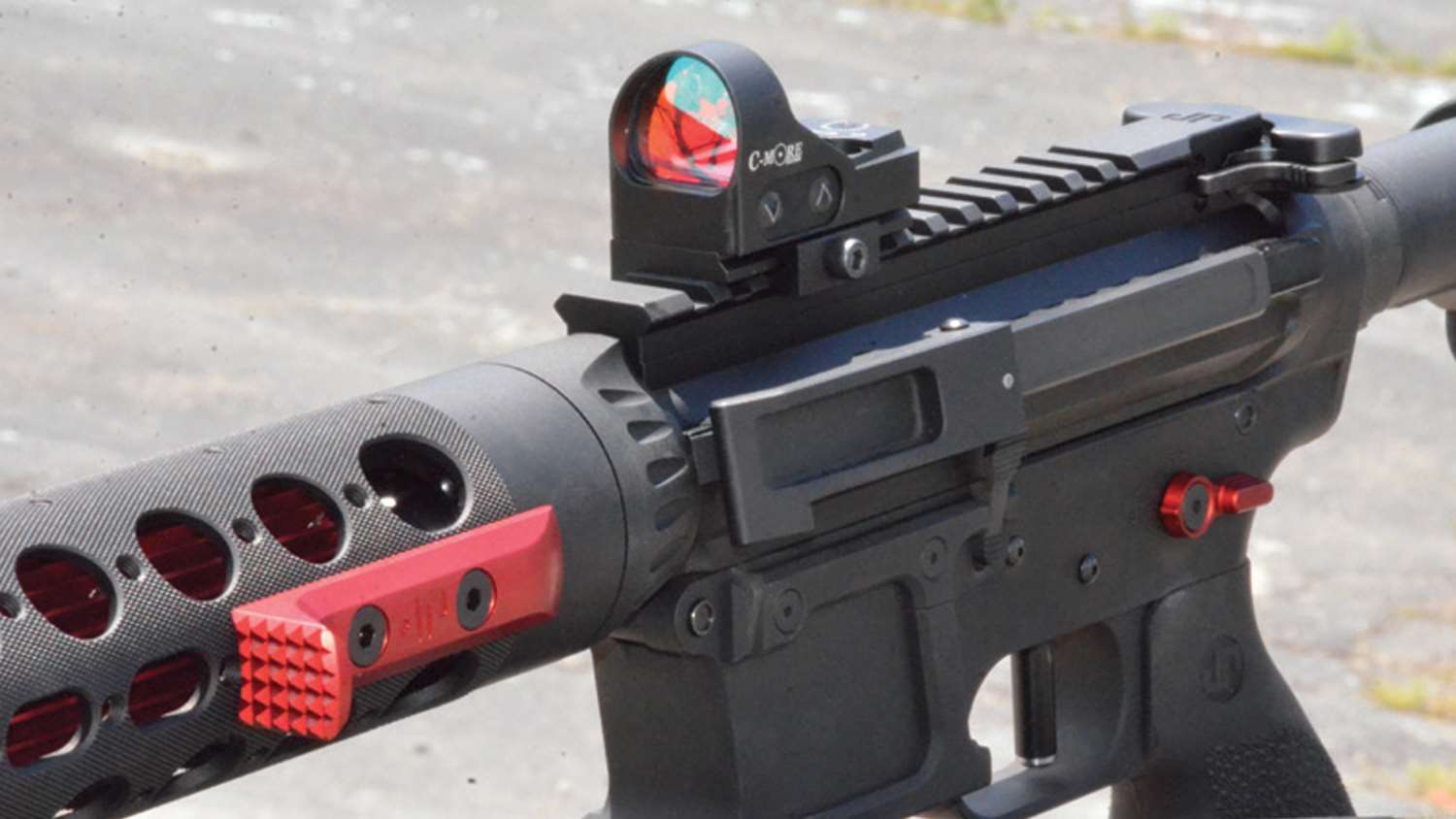
The second feature that stood out was the left-side charging handle. The traditional charging handle can be awkward of cumbersome in the Unload and Show Clear process; this new charging handle folds forward into its rest position so as to not snag or catch on things while shooting, but drastically simplifies showing a clear chamber for right-handers. While working the SNS Match as an RO, I watched PCC shooters to a greater degree than I normally do. It was obvious with a number of those PCC shooters a left-side charging handle would greatly simplify the Unload and Show Clear process. While the feature would be valuable in that process―that is not where it would pay the biggest dividends. The ability to rack the bolt while keeping the carbine mounted to the shoulder would be a huge time-saver in the event of a high primer or dud round, or a tap-rack-bang procedure in the event of a magazine that was not seated. (Try running the bolt with the traditional charging handle and keeping the gun mounted.) I could see this left-side charging handle catching on like five gallon buckets, baling wire and pockets. There is nothing superfluous with this charging handle. JP Enterprises scores well again.
The second range session was the week following the Mile High Showdown and took place at the NRA Whittington Center near Raton, NM, in a very dry heat. (The Whittington Center is very cool, check it out if you get the chance.) The ammunition used was a mixture of American Eagle 124-grain and my own reloads. My son and I gave the carbine a second workout for several hours. This session was also malfunction free, and the carbine was accurate. It was able to put headshots on target at 25 yards repeatedly, without a single miss, from the low ready position common among USPSA classifier stages. With just snapping the carbine up and firing a single shot, or with firing several shots, the gun was accurate and the recoil was easy to control, perhaps due to the compensator, or maybe my sheer mass. Whatever the reason, I wish 25-yard head shots could be achieved so consistently and easily with my Limited gun.
One drill was snapping the gun up and firing one shot on a target at the distance of 12 yards, the PCC equivalent of a draw. The first shot was a Bravo in 1.50 seconds. At this point I noticed the dot was not turned on, but once that was corrected, each shot resulted in an Alpha, with times ranging from 1.27 to 1.68 seconds for a batch of 10 draws. With a little bit of practice the time could be drastically diminished with the same accuracy. The GMR points well and is comfortable once it is mounted to a shooting position. It was a struggle to smoothly mount the gun, but that was due to a lack of familiarity with the platform, not the carbine itself.
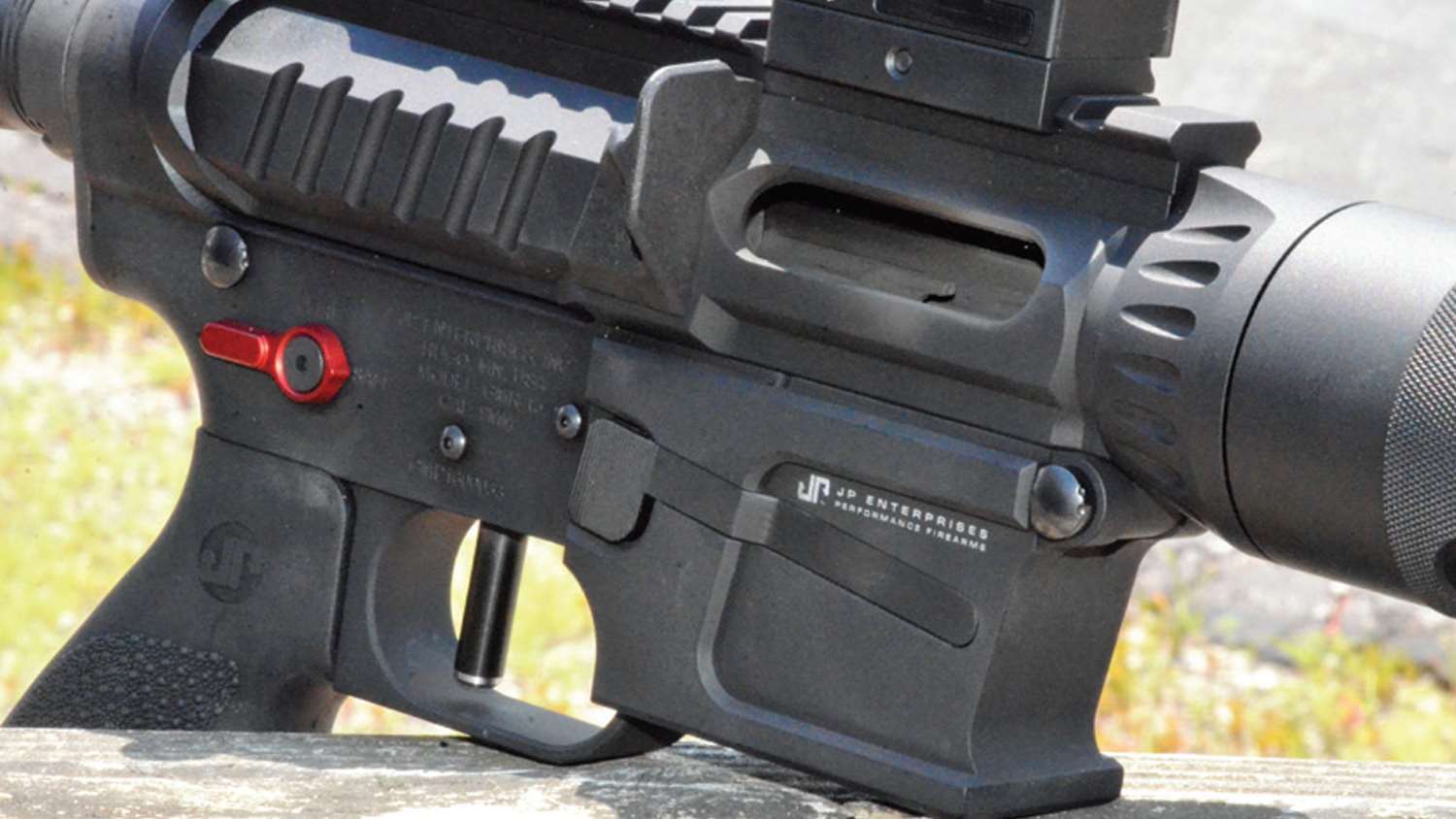
The next drill was a three-target array set up in a near-to-far pattern. The close target was at 12 yards, the second at 19 yards and the third at 25 yards. From the standard start position on many classifiers, the targets were engaged with two rounds each as fast as a sight picture could be established. This drill of six shots was repeated six times without looking at or examining the targets. The times were 3.94, 3.94, 4.17, 3.52, 3.60 and 3.73 seconds. Target one had five Alphas, four Bravos and three Charlies. Target two had 10 Alphas and two Charlies. Target three had 11 Alphas and one Charlie. The accuracy was very acceptable, particularly on the farther targets.
This range session so far confirmed the original view that the GMR was a very well-built gun that would perform in a reliable and accurate manner. Just plinking around, shooting groups or running drills and exercises at speed, this gun was a shooter and it looked good doing it.
The GMR has two issues or “flies in the ointment”, however; the first fly in the ointment is price. The price tag is not for the faint of heart, although price is an issue for some folks and not for others. It is no surprise that a fine gun is going to cost more than a cheap gun out of the box. The price is comparable to a Limited gun.
The other fly in the ointment reared its ugly head prior to this range session, was that of getting the magazine to drop free from the carbine while shooting a stage. This is something that is no big deal when it comes to shooting field courses; a large magazine capacity takes away the necessity of a reload. However, classifiers and standards require reloads, and in these situations it is impossible to be competitive if the magazine will not drop free. I set up a longer and wider version of El Prez, with targets at a distance of 12 yards and three yards apart, a more difficult shooting challenge than the classifier version. I recorded the first two runs on this array as 8.48 and 8.85 seconds respectively, with only one Charlie per run; the rest were Alphas. In both runs, it was necessary to pull the magazine from the carbine, and every drill involving a reload had the same result. Jake Martens had discovered this in a previous range session. I gathered a number of different magazines, polished them up with Armor All, and still could not make any of them fall free when they were loaded, although some would drop free when empty. Jake talked with a JP Enterprises representative about this issue and was assured that the problem has been fixed since this particular carbine had been assembled.
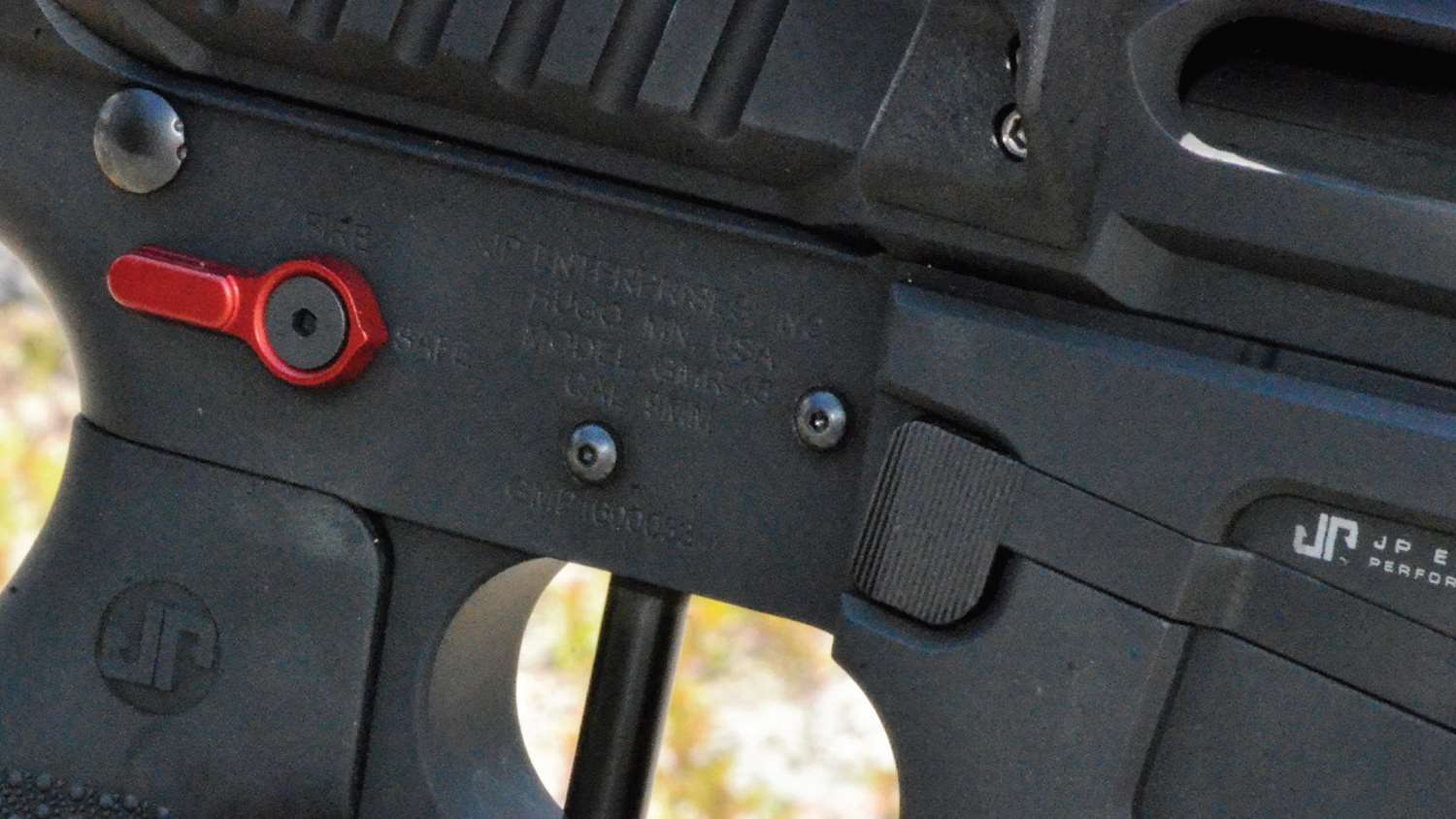
Gunnar An from JP said, “So, we have found that some of the newer Glock 33-round mags are little wider or bulge too much and the magwell area is very tight. We do have a process to widen these areas on GMR units on site. However, these are more than likely specific to the demo unit you have, which was an earlier version of the unit that was recoated. New units will not reflect this issue when ordered.”
Jake and I met up at the Riley Conservation Club’s monthly steel match last summer, where we both shot the GMR. Neither of us is a carbine or rifle guy, but this gave us the opportunity to test the GMR in competition. This match was seven stages long, and six of the stages were the official Steel Challenge courses. The regular PCC crew kicked the living (expletive) out of us. Our lack of carbine handling skills was evident. In my case, the last three stages were much more competitive, as I was getting settled into the gun and getting more comfortable and therefore was able to shoot faster. The GMR ran malfunction-free the entire time. We used some Federal ammunition and some reloads. Accuracy was easy to accomplish, and the gun did its part, but the lack of shooting skill resulted in slower times. Still, the match was approached as an experiment with the carbine, a sort of “first date” as it were, in order to see what was possible. In that respect, the match was a success. After shooting seven stages of Steel Challenge it was obvious how well this gun performed. Steel Challenge with a PCC is much easier than with a centerfire pistol and much more fun. Times could be achieved with the GMR that could not be accomplished with a pistol, despite having years of pistol experience.
The conclusion has been eye-opening in regard to the high level of performance by this specific carbine, and by carbines in general. JP Enterprises makes a fine product that will perform at a very high level. If the budget will allow, the GMR is the way to go. As more and more shooters are considering PCC as a division, the demand for a quality carbine will increase. JP Enterprises has a great option for meeting that demand, and serious PCC competitors should give them consideration before making a purchase.
The GMR-15 starts at $1699 and it is ready to go from the box. If you decide to add the left side charge handle option, the upper receiver changes to a billet aluminum and adds $600 to the build price. Get on JP’s website and explore the Rifle Builder to spec one out. JP also offers all the parts and accessories for those of you who want to build out your own carbine or AR.
Article from the September/October 2017 issue of USPSA’s FrontSight magazine.













